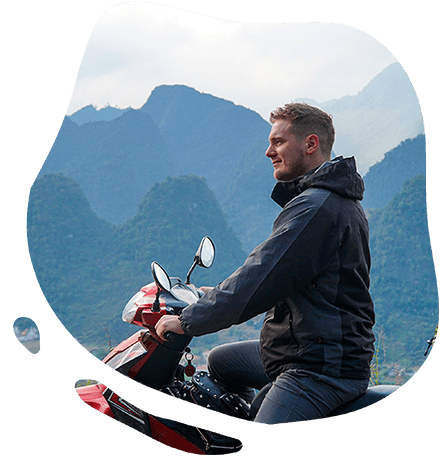How safe is the Ha Giang Loop?
The people
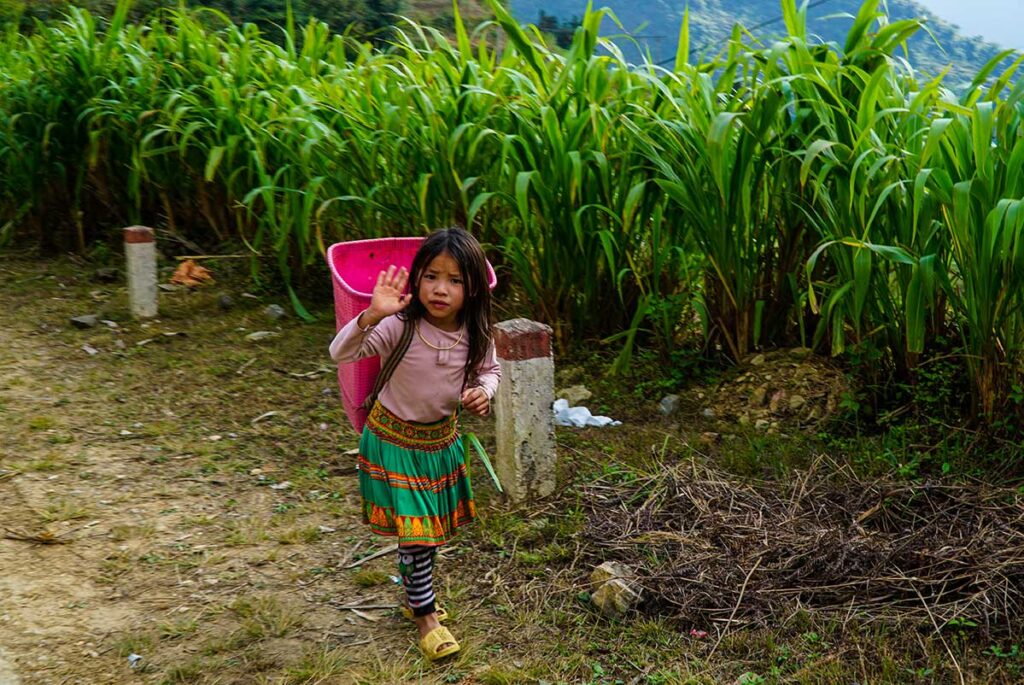
Ha Giang is home to various ethnic minorities, who are among the friendliest people you’ll meet in Vietnam. Children often wave at passing tourists, while adults in rural areas might stare curiously but are generally welcoming. Incidents of crime against tourists are extremely rare. However, it’s always wise to be vigilant; make sure to lock up your motorbike and keep your belongings secure. Overall, there’s little cause for concern when it comes to personal safety.
The roads
As the Ha Giang Loop gains in popularity, the government has invested significantly in improving road infrastructure. Most notably, the stretch from Ha Giang to Dong Van and from Dong Van to Meo Vac—known as highway QL4C—is well-maintained and in excellent condition.
On the flip side, the route from Meo Vac to Ha Giang City via the DT176 and DT182 is under construction and features large segments of dirt roads. These can become particularly slippery and challenging to navigate after rain.
Regardless of the road condition, always proceed with caution. Factors like rain, heavy trucks, and rockfalls can create hazardous potholes quite suddenly, so defensive driving is advised even on seemingly perfect roads.
Traffic
Ha Giang is a sparsely populated province, and many of its residents are poor ethnic minority communities. As a result, there are few cars on the road, with most locals relying on motorbikes or walking. This generally results in less chaotic traffic conditions.
However, the area’s growing popularity has led to increased tourist traffic, especially in weekends and holidays. While most tourists are cautious as they too are there for sightseeing, be aware that some may be inexperienced motorbike drivers, posing unintentional road risks.
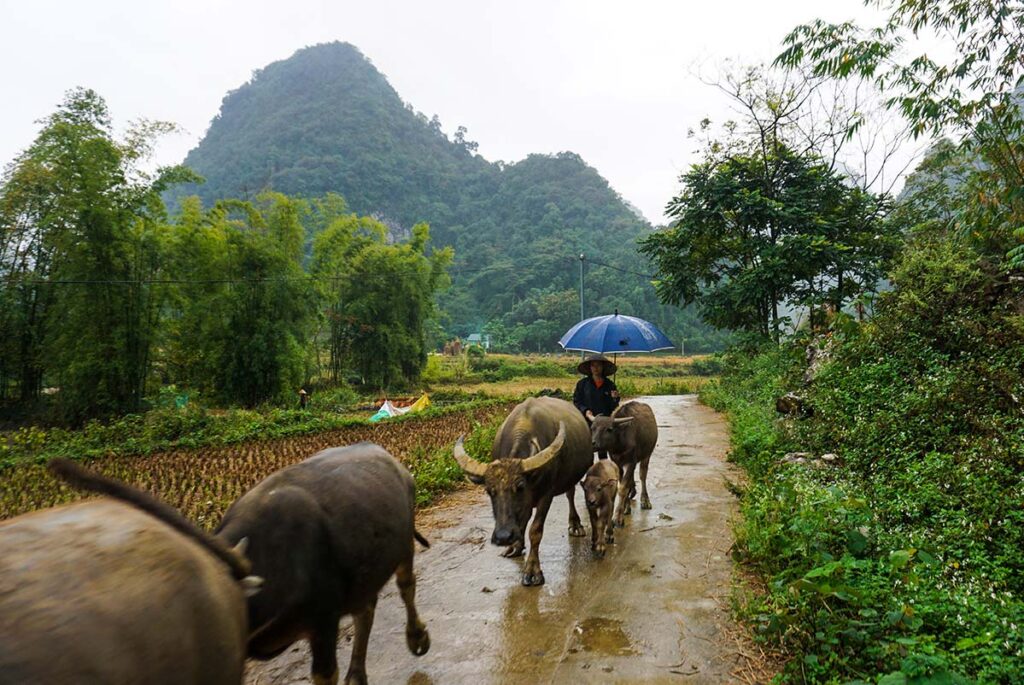
Furthermore, the growing tourism industry has spurred construction activity, leading to a noticeable presence of trucks on the road. These trucks move slowly due to the mountainous terrain but require extra caution when overtaking, especially on curves.
Weather hazards
Being a mountainous region, Ha Giang is prone to certain weather-related risks. Heavy rains can trigger landslides and make roads slippery. Unpaved sections can turn muddy and difficult to navigate.
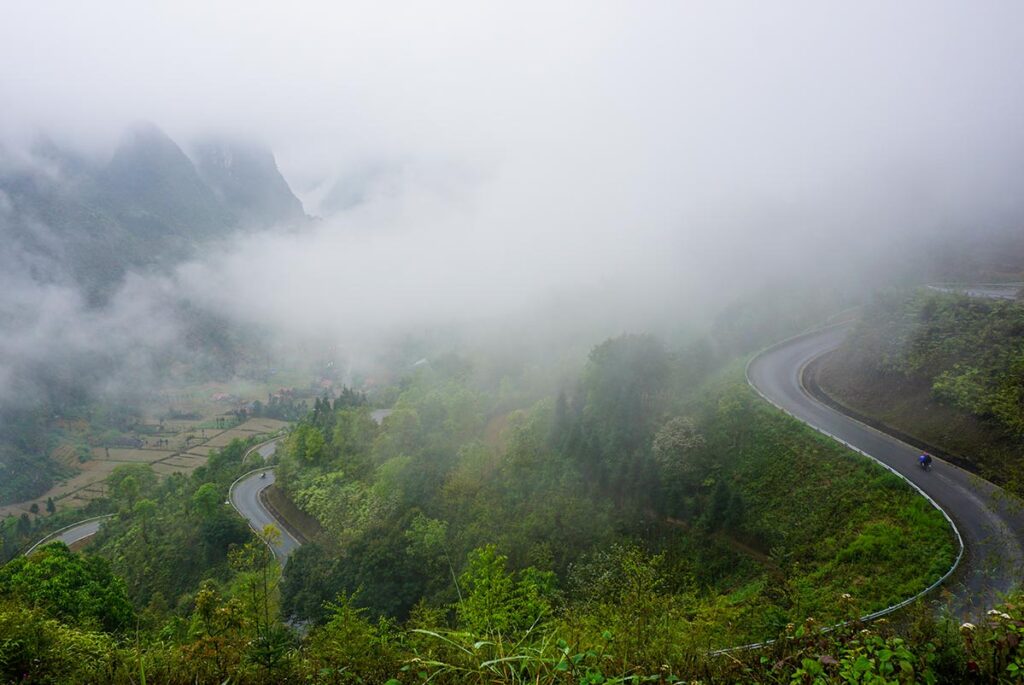
Best and worst seasons for riding
The rainiest months in Ha Giang are June and July, requiring extra caution while driving. During the cold winter months of December and January, fog is more likely, reducing visibility and making driving more challenging.
Spring and Autumn are generally the best seasons for doing the Ha Giang Loop, but always be prepared for the possibility of fog and rain.
How safe is driving the Ha Giang Loop by motorbike?
For those with experience riding motorbikes, the Ha Giang Loop generally offers a safe driving environment. The roads are mostly well-maintained, and the traffic is relatively light. However, caution is advised. Always drive defensively to account for potential road hazards like potholes, animals, or tourists stopping to take photos. Also, keep an eye out for less-experienced drivers who may be unfamiliar with the road conditions.
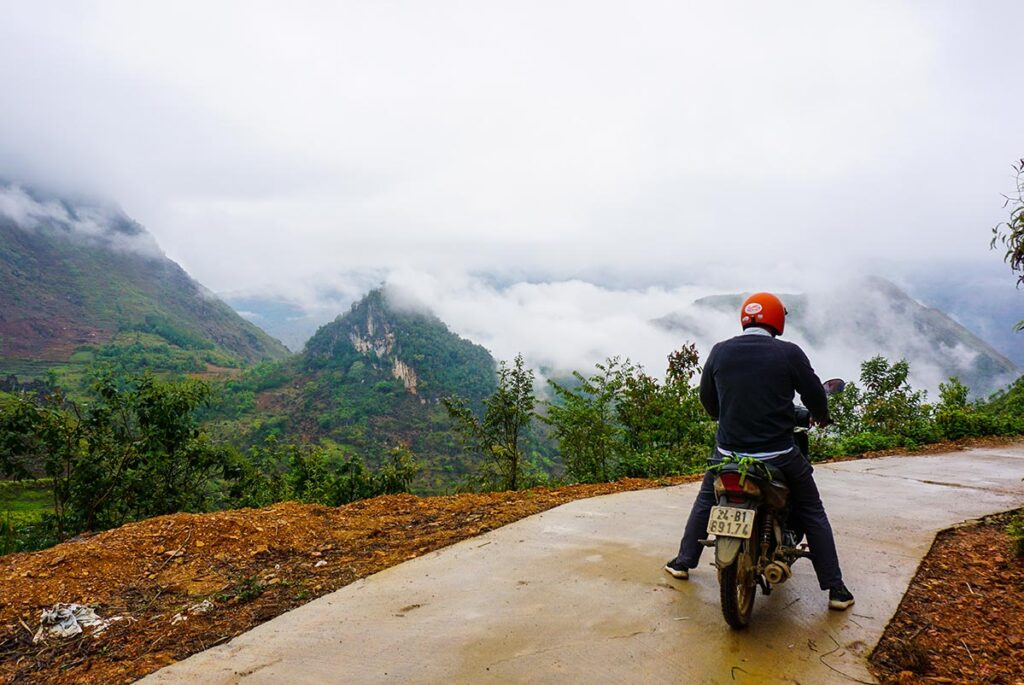
If you’re not an experienced motorbike rider, tackling the Ha Giang Loop is not recommended. Vietnam, and Ha Giang’s mountainous areas in particular, are not the places to cut your teeth on motorbike riding. Additionally, if you lack a proper motorbike license, you should be aware that you may not be fully covered by insurance in the event of an accident. Authorities could also issue fines if you’re found driving without the proper documentation.
Safer alternatives for driving motorbike in Ha Giang
If you lack experience in motorbike riding or don’t possess a valid license but still wish to experience the exhilarating Ha Giang Loop, an excellent alternative is to book an “Easy Rider” tour.
Easy Riders are local guides who have spent their lives navigating these mountainous terrains and are intimately familiar with every road and corner. Opting for this service provides not only a safer alternative but also offers the unique advantage of local insights. These experienced riders can take you to hidden gems you might not discover on your own and provide a rich cultural context during your journey.
Driving guidelines and etiquette
Navigating the scenic roads of Ha Giang can be a thrilling experience, but it’s crucial to familiarize yourself with the local driving guidelines and etiquette for a safe and enjoyable trip.
Local laws and customs
In Ha Giang, as in the rest of Vietnam, you should drive on the right side of the road. Always carry your driving license, bike registration, and insurance documents. In some areas, you may encounter checkpoints where these documents will be verified.
Speed limits and overtaking
Speed limits vary but are generally 40-50 km/h in cities and can go up to 60-70 km/h on highways. Overtaking should always be done cautiously, especially on Ha Giang’s winding roads. Always overtake from the left and make sure the road ahead is clear. Due to the mountainous terrain, anticipate sharp turns and proceed with caution.
Honking and signaling
Honking is commonplace in Vietnam and serves as a signal to other road users of your presence. However, excessive honking in rural and quiet areas is frowned upon. Use your indicators for turning or changing lanes and flash your high beams to signal your intent to overtake.
Proper gear and equipment
Always wear a helmet that meets safety standards. It’s not just the law, but also a vital safety measure. Gloves, knee pads, and proper shoes can provide additional protection. Make sure your motorbike is equipped with working lights, mirrors, and a horn. Carry a basic repair kit for minor roadside repairs and always keep an eye on the fuel gauge, as petrol stations can be scarce in some areas.
Health in Ha Giang
Ensuring your well-being during your trip to Ha Giang is crucial. The region, while stunning, does come with its own set of health considerations ranging from food hygiene to local wildlife. Here’s what you should know to have a safe and enjoyable journey.
Food & Hygiene
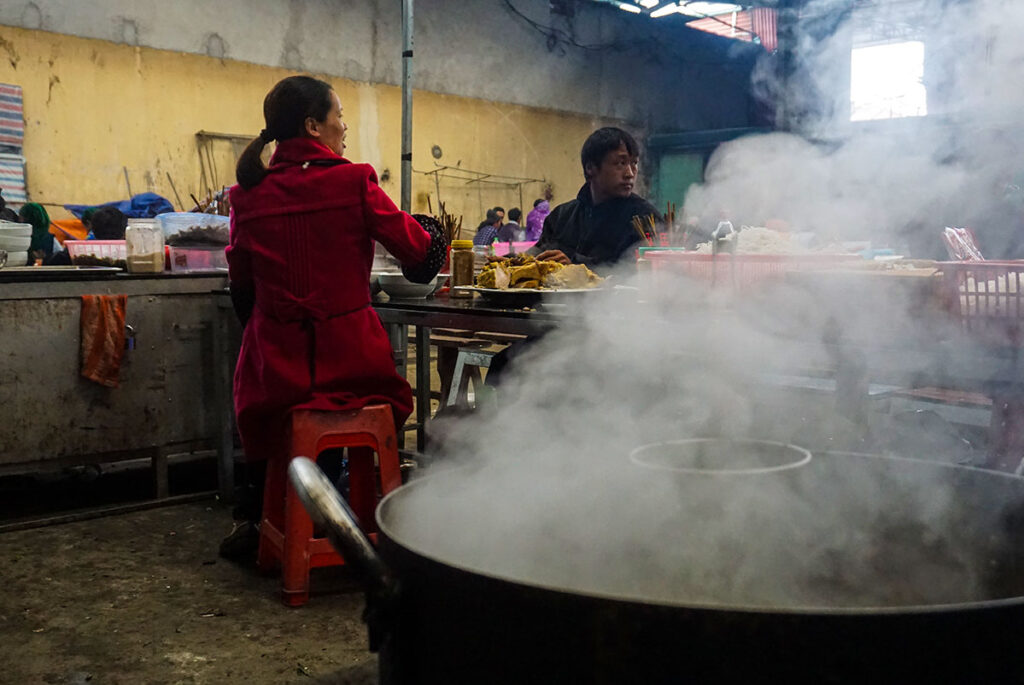
Street food and local delicacies are an essential part of the Ha Giang experience. However, it’s important to exercise caution. Always opt for freshly cooked food and drink bottled or boiled water. If you have a sensitive stomach, it might be wise to carry antidiarrheal medication.
Mosquitos
Ha Giang is not known for mosquito-borne diseases like malaria or dengue fever, but it’s always good to be cautious. Wearing long sleeves and trousers during dusk and dawn, using insect repellent, and sleeping under mosquito nets in more rural areas can help you avoid bites.
Stray dogs
While not a significant concern, you might encounter stray dogs in Ha Giang. It’s advisable to avoid contact, as rabies is a concern in some areas of Vietnam. If you’re bitten, seek medical attention immediately for proper treatment.
Wildlife
As a mountainous region, Ha Giang is home to various species of wildlife. Though encounters are rare, it’s crucial to know what to do if you come across snakes or other potentially dangerous animals. Keep a safe distance, make slow movements, and do not provoke them.
Hospitals
Medical facilities in Ha Giang are limited compared to larger cities. It’s a good idea to know the location of the nearest hospital and have a basic understanding of how to get there. In case of serious medical issues, you might have to be evacuated to Hanoi, which can be time-consuming and costly.
First Aid Kit Essentials
Carrying a basic first aid kit can be a lifesaver. Essentials should include antiseptic wipes, bandages, pain relievers, antidiarrheal medication, and any prescription medications you may need. It might also be useful to have rehydration salts and anti-allergy medication.
Ha Giang Loop safety tips
1. Consider an Easy Rider
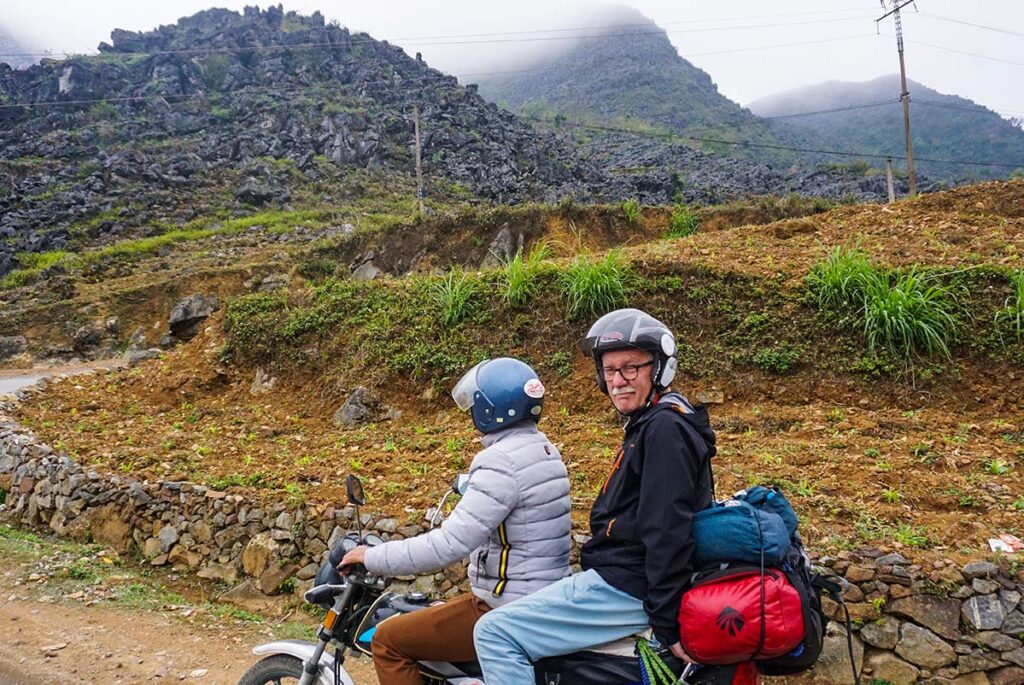
If you’re not experienced with motorbike riding or unfamiliar with mountainous terrains, hiring an Easy Rider can be a smart choice. These local experts can navigate the challenging roads, offer cultural insights, and take you to hidden spots you might otherwise miss.
2. Recommended Apps for translation and navigation
Apps like Google Translate can be indispensable for communicating, especially in remote areas where English is not widely spoken. For navigation, consider offline map apps like Maps.me or Google Maps’ offline feature, so you’re not reliant on an internet connection.
3. Check your travel insurance
Before embarking on your journey, make sure your travel insurance covers motorbike riding and any possible medical emergencies in Vietnam. Read the policy carefully, especially the fine print, to ensure you’re adequately covered.
4. Common phrases for emergency
Learning some essential Vietnamese phrases for emergencies can be extremely helpful. Some basic ones include “Cứu tôi!” (Help me!), “Tôi bị thương” (I am injured), and “Bệnh viện ở đâu?” (Where is the hospital?).
5. Check the weather
Weather conditions can change quickly in mountainous regions. Always check the weather forecast before setting out and plan your trip accordingly. Rain can make the roads slippery and fog can reduce visibility drastically.
6. Equip proper safety gear
Wearing appropriate safety gear is crucial. This includes a good-quality helmet, knee and elbow pads, and a high-visibility jacket or vest. Make sure your gear fits well and is in good condition.
7. Maintain your motorbike
Before starting your journey, thoroughly check your motorbike for any maintenance issues. Make sure the brakes are working, the tires are inflated, and the lights and signals are functional.
8. Be mindful of the time
Plan your day so that you’re not riding in the dark. Mountain roads can be treacherous, and lack of light will only compound the risks. Try to reach your day’s destination well before sunset.
9. Carry essential supplies
Pack a first aid kit, enough water, and some non-perishable food items when you’re on the road. You may not always have quick access to shops, especially when driving through remote areas.

